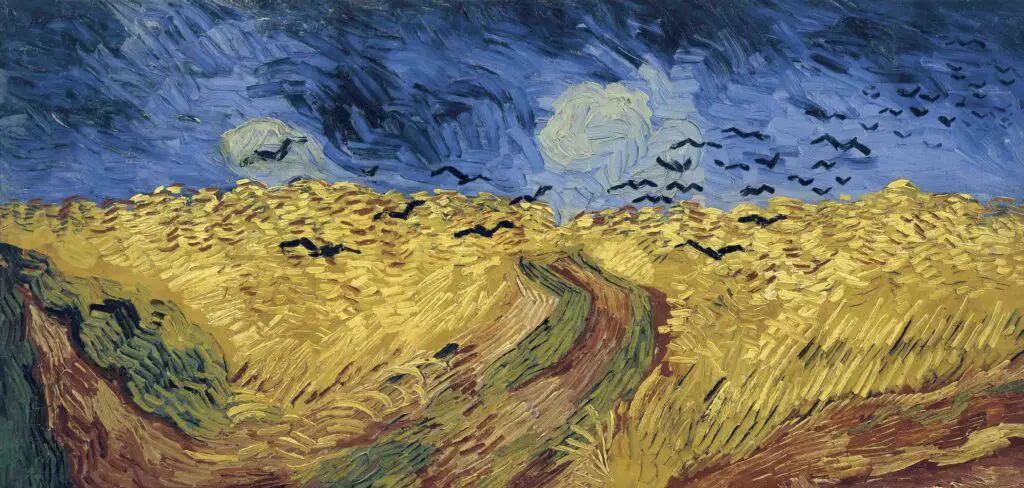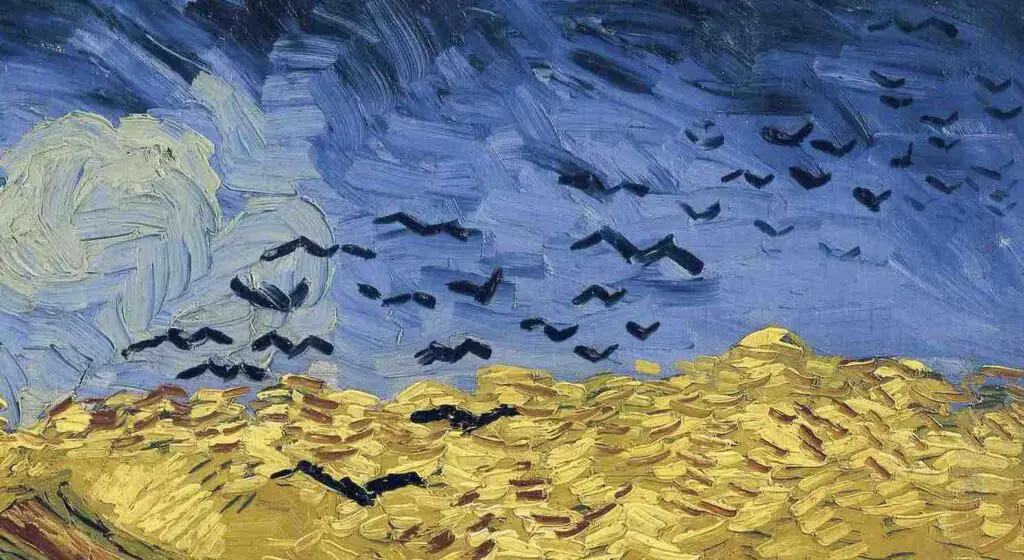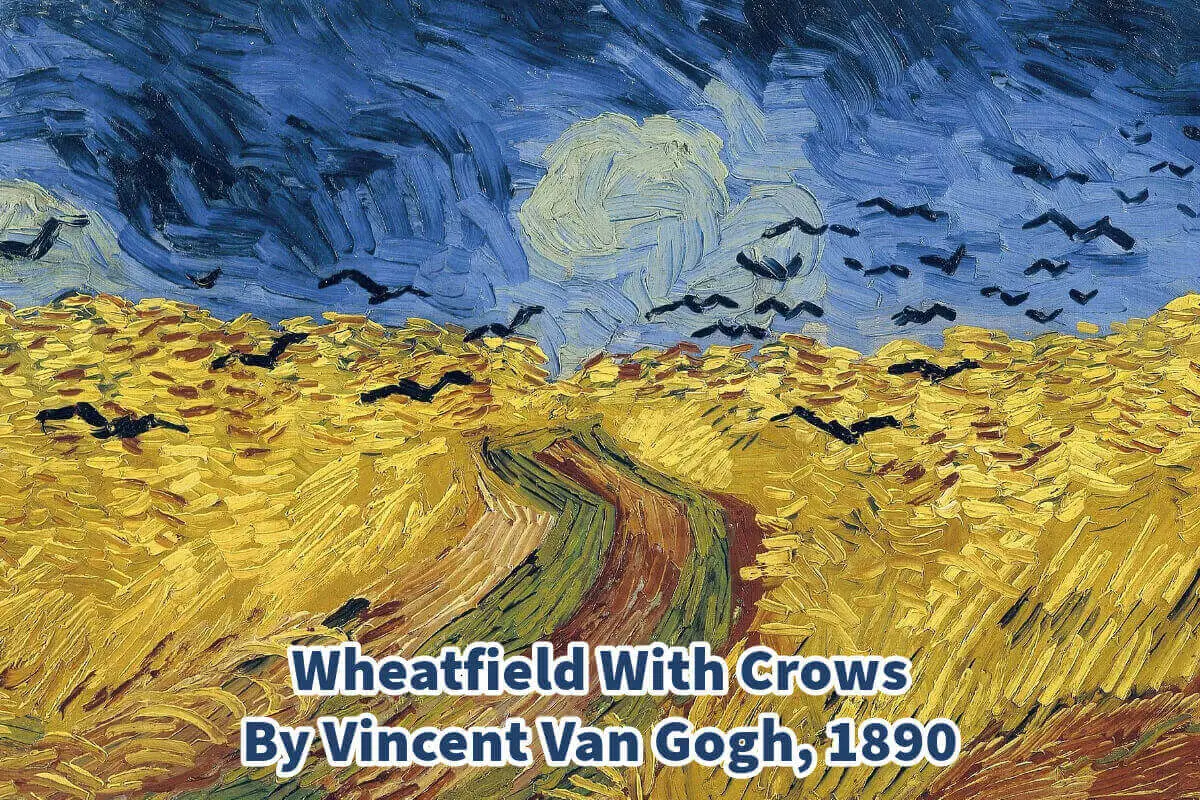Vincent Van Gogh, a name inseparable from artistic brilliance and profound emotional depth, has bequeathed to the world a treasury of masterpieces that continue to enchant and bewilder art fans across the globe. Among his illustrious oeuvre, “Wheatfield with Crows” emerges not solely for its arresting visual allure. Still, also, for the kaleidoscope of emotions and interpretations, it has stirred over time.
Although often erroneously touted as Van Gogh’s final brushstroke, this magnum opus is a poignant embodiment of his tumultuous existence and visionary creativity. Join us on a journey as we dissect the import of “Wheatfield with Crows” and unravel why its resonance extends beyond the realm of art.
Table of Contents
- Unveiling The Beauty And Complexity Of “Wheatfield With Crows” By Vincent Van Gogh
- The Elements Of “Wheatfield With Crows”
- Interpreting The Significance Of The Wheatfield With Crows
- Frequently Asked Questions
- Related Questions
Unveiling The Beauty And Complexity Of “Wheatfield With Crows” By Vincent Van Gogh
Vincent Van Gogh, synonymous with artistic genius and emotional intensity, left behind a legacy of masterpieces that continue to captivate and mystify art enthusiasts worldwide. Among his most iconic works, “Wheatfield with Crows” stands out not only for its striking visual appeal but also for the myriad of emotions and interpretations it has evoked over the years.

Often mistakenly believed to be Van Gogh’s last painting, this masterpiece is a poignant representation of his tumultuous life and creative vision. Read on as we delve into the significance of “Wheatfield with Crows” and explore why it matters in art and beyond.
The Myth Of Van Gogh’s Last Work
Before we immerse ourselves in the depths of “Wheatfield with Crows,” let’s dispel a persistent myth. It is widely circulated that this painting marks Van Gogh’s final artistic creation, symbolizing his impending demise.
While the painting exudes a sense of foreboding and melancholy, correcting the misconception that this was his last work is essential.
In reality, Van Gogh produced several other pieces after completing “Wheatfield with Crows.” However, the myth persists, underscoring the powerful impact of this artwork on our collective imagination.
The Elements Of “Wheatfield With Crows”
To truly appreciate the importance of “Wheatfield with Crows,” we must dissect its various elements, each contributing to the overall narrative of the painting.
The Menacing Sky
The sky in “Wheatfield with Crows” immediately draws the viewer’s attention. It is a swirling, tumultuous sea of dark blues and grays, dominated by ominous, billowing clouds.

This sky is in perpetual turmoil, casting an eerie shadow over the below wheatfield. The tumultuous sky is often interpreted as a reflection of Van Gogh’s inner turmoil and emotional struggles.
It speaks to his isolation, despair, and tumultuous mental state.
The Crows
Crows, dark and foreboding, are a central motif in the painting. They swirl above the wheatfield, creating a sense of chaos and unease. In art, crows are often symbolic of death or omens of impending doom.

In this painting, Van Gogh’s use of crows adds to the prevailing sense of darkness and foreboding. However, it is essential to note that Van Gogh was generally fascinated with birds and painted them in various works, not exclusively as harbingers of doom.
The Dead-End Path
The path in “Wheatfield with Crows” leads to a dead end, disappearing into the tumultuous wheatfield. This dead-end path frequently represents Van Gogh’s hopelessness and despair.

It symbolizes a journey without a destination, mirroring the artist’s struggles in life.
Color Palette
Van Gogh’s use of color in this painting is nothing short of masterful. The stark contrast between the vibrant yellow-orange wheat and the deep blue sky is striking.
The red path that cuts through the wheatfield intensifies the overall composition. Green bands of grass bordering the path balance the composition and add depth to the scene.
Van Gogh’s bold and expressive use of color captures the viewer’s attention and conveys a range of emotions, from the vibrancy of the countryside to the heaviness of his heart.
Interpreting The Significance Of The Wheatfield With Crows
Now that we have explored the elements that makeup “Wheatfield with Crows,” let’s delve into why this painting is considered essential and why it matters in art and beyond.

Emotional Depth And Expression
One of the foremost reasons for the enduring importance of “Wheatfield with Crows” lies in its emotional depth and Van Gogh’s ability to convey his innermost feelings through his art. Van Gogh’s struggles with mental health, loneliness and despair, and relentless pursuit of artistic expression are all encapsulated within this canvas.
The tumultuous sky, the ominous crows, and the dead-end path are not merely decorative elements; they serve as windows into the artist’s soul. This emotional resonance continues to captivate audiences and reinforces that art is a powerful medium for conveying complex human emotions.
Artistic Innovation
Van Gogh’s innovative use of color and brushwork in “Wheatfield with Crows” showcases his daring approach to art. He rejected the traditional conventions of his time, opting for bold and expressive techniques that pushed the boundaries of what was considered acceptable in the late 19th century.
His use of contrasting colors and thick, swirling brushstrokes adds a dynamic and energetic quality to the painting. This departure from convention not only influenced the development of modern art but also continues to inspire artists to experiment and push the limits of their creativity.
A Window Into Van Gogh’s Worldview
“Wheatfield with Crows” offers a glimpse into Van Gogh’s worldview and complex relationship with nature. On the one hand, the painting reflects his sense of isolation and despair, symbolized by the menacing sky and the dead-end path.
On the other hand, it embodies his deep connection to the countryside and his belief in the healing power of nature.
Van Gogh wanted to convey the duality of his emotions – the sadness, loneliness, and the vitality and fortitude he found in the rural landscapes he depicted. This dual perspective allows viewers to contemplate the complexity of human existence and the coexistence of beauty and suffering.
The Endurance Of Myth And Symbolism
The enduring myth that “Wheatfield with Crows” was Van Gogh’s last work speaks to the enduring power of symbolism in art. Symbols like the crows and the dead-end path hold a universal appeal because they tap into primal human emotions and fears.
The painting’s continued association with Van Gogh’s tragic life story only adds to its allure. This myth reminds us that art is not static but can take on new meanings and interpretations over time, connecting with different generations in unique ways.
“Wheatfield with Crows” by Vincent Van Gogh is a masterpiece that continues to captivate and intrigue art enthusiasts worldwide. Its emotional depth, innovative use of color and brushwork, and ability to illuminate the artist’s worldview all contribute to its enduring significance.
Moreover, the persistence of the myth surrounding this painting serves as a testament to the enduring power of art to evoke emotions, inspire creativity, and connect with the human experience. As we gaze upon this tumultuous wheatfield and ominous crows, we are reminded of the complexities of life and the enduring legacy of one of history’s greatest artists.
Anita Louise Art is dedicated to art education, great artists, and inspiring others to find and create their art. We love art that uplifts and inspires. #ArtToMakeYouSmile! #ArtToMakeYouHappy!
If you want to see any of my art, you can find out more by clicking here. If you are interested in what inspires me and my paintings, you can discover more by clicking here.
We have a free newsletter and would love you to be part of our community; you can subscribe to the newsletter by clicking here. If you have any questions, I would be happy to talk to you anytime. You can reach me, Anita, by clicking here.
Subscribe to our Anita Louise Art YouTube Channel with great videos and information by clicking here.
Join us for our podcast “5 Minutes With Art.” Spend just 5 minutes a week with us to discover and learn about great art and artists. You can find out more about our podcast by clicking here.
Frequently Asked Questions
What is “Wheatfield with Crows” by Vincent Van Gogh, and when was it created?
“Wheatfield with Crows” is a famous painting by Vincent Van Gogh, created in 1890, the last year of his life. Despite being commonly associated with his final moments, it’s not definitively proven to be his last artwork.
What is the significance of the crows in the painting?
The crows in the painting are often interpreted as symbols of death, despair, or Van Gogh’s own troubled state of mind. Some view them as harbingers of doom, while others see them as a representation of the artist’s inner turmoil.
Is “Wheatfield with Crows” Van Gogh’s last painting?
Although often mistakenly believed to be his final work, there is no conclusive evidence that “Wheatfield with Crows” was Van Gogh’s last painting. The uncertainty surrounding his last moments adds a layer of intrigue to the interpretation of this masterpiece.
How does the use of color contribute to the emotional impact of the painting?
Van Gogh’s masterful use of color in “Wheatfield with Crows” is striking. The bold and swirling hues evoke a sense of turbulence and intensity, reflecting the artist’s emotional state. The contrasting colors create a dynamic and emotionally charged atmosphere within the painting.
What are the different interpretations of the wheatfield in the painting?
The wheatfield in the painting has been interpreted in various ways. Some see it as a symbol of life and growth, contrasting with the ominous crows overhead. Others perceive it as a representation of the cycles of nature and the fleeting nature of existence.
How does “Wheatfield with Crows” reflect Van Gogh’s mental state at the time?
Many art historians and psychologists analyze the painting in the context of Van Gogh’s mental health. The turbulent sky, ominous crows, and the intense colors are often seen as expressions of the artist’s inner struggles and emotional turmoil during his final days.
Are there any self-portrait elements in “Wheatfield with Crows”?
Some art critics and scholars suggest that elements of self-portraiture can be found in the painting. They argue that the landscape and the crows may symbolize aspects of Van Gogh’s own psyche, offering a glimpse into his troubled mind.
How has the interpretation of “Wheatfield with Crows” evolved over time?
Van Gogh employed his signature impasto technique in “Wheatfield with Crows,” applying thick layers of paint to create a textured surface. This technique enhances the emotional impact of the painting, adding depth and intensity to the swirling clouds and wheatfield.
Related Questions
Discovering Van Gogh: Van Gogh Museum Amsterdam
The Van Gogh Museum in Amsterdam is a world-renowned cultural institution that attracts art lovers and enthusiasts from around the globe. It is home to the most extensive collection of works by the legendary Dutch artist Vincent van Gogh. Visitors can explore Van Gogh’s fascinating life and career through a diverse collection of over 200 paintings, 500 drawings, and 700 letters. The museum constantly has new and exciting collections that also reflect upon the work and life of Vincent Van Gogh.
By clicking here, you can learn more by reading Discovering Van Gogh: Van Gogh Museum Amsterdam.
Why Vincent Van Gogh Is Such A Famous Painter
Vincent van Gogh is considered one of the greatest painters who ever lived. He is one of the most famous painters that most people know about today. He is well known for his vivid use of colors and emotion within his paintings. But more than that, he had a unique style that resonated with many for hundreds of years.
By clicking here, you can discover more by reading Why Vincent Van Gogh Is Such A Famous Painter.
Guide To The Irises By Vincent Van Gogh
One of the most famous iris paintings that people talk about is van Gogh’s Irises, which are blue against a yellow background. But van Gogh also, at the same time, painted a second iris, which had a pink background. He also painted some roses with a green background at the same time. We know from his letters that these paintings for him were a study of using color combinations.
By clicking here, you can discover more by reading Guide To The Irises By Vincent Van Gogh.


